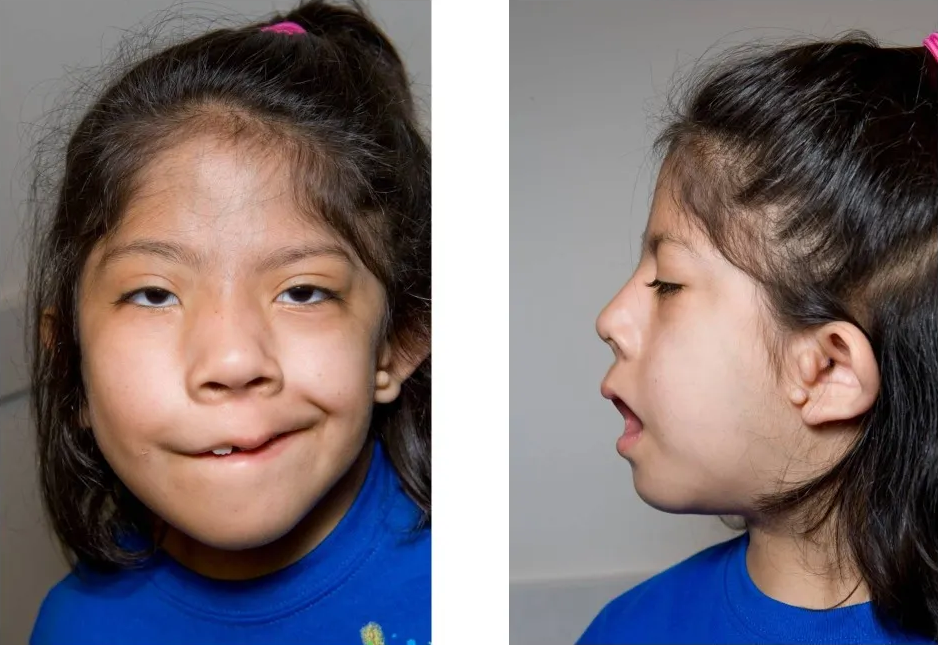Oculo-Auriculo-Vertebral Spectrum

A rare congenital malformation syndrome, most commonly presenting with hemifacial microsomia associated with ear and/or eye malformations and vertebral anomalies of variable severity. Additional malformations involving the heart, kidneys, central nervous, digestive and skeletal systems may also be associated.
Epidemiology
The prevalence at birth is less than 1/26,000 in Europe, with a slight male predominance.
Clinical description
The phenotypic spectrum ranges from isolated mild facial asymmetry to severe bilateral craniofacial microsomia and additional multiple extracranial abnormalities. Craniofacial involvement is typically unilateral; the most common manifestations are auricular abnormalities, preauricular appendages and/or fistulas, hypoplasia of the mandible, maxilla, malar bone, and/or zygomatic arch, and epibulbar dermoids. Airway obstruction due to mandibular and maxillary hypoplasia can be life threatening. Auricular abnormalities are usually unilateral and include microtia, ear malpositioning and external auditory canal atresia or stenosis, with or without hearing loss. Ocular involvement may range from an upper eyelid coloboma to micro/anophthalmia in severe cases. Facial palsy, asymmetric palatal elevation, impairment of extraocular movements and trigeminal anesthesia have been reported. Congenital heart defects, such as tetralogy of Fallot, septal defects, transposition of the great vessels, aortic arch anomalies, situs inversus, and dextrocardia are not uncommon. Additional features may include renal (unilateral kidney agenesis, double ureter, renal ectopia, hydronephrosis, hydroureter) and central nervous system (developmental delay, microcephaly, encephalocele, hydrocephaly, corpus callosum hypoplasia, Arnold-Chiari malformation, holoprosencephaly) anomalies. Intelligence is typically normal.
Etiology
The etiology is poorly understood but is suspected to be heterogeneous and multifactorial. The gene MYT1 (20q13.33) has been Implicated in a few rare cases, and chromosomal abnormalities have been associated with some of the congenital malformations associated with this condition.
Diagnostic methods
Diagnosis is based on clinical findings. Microtia and/or mandibular hypoplasia with a preauricular tag have been suggested as diagnostic; however, there are no established guidelines for the minimum diagnostic criteria.
Differential diagnosis
Differential diagnosis includes syndromes associated with microtia and mandibular hypoplasia, including Treacher Collins syndrome, Townes-Brocks syndrome, CHARGE syndrome, branchio-oto-renal spectrum disorders, mandibulofacial dysostosis with microcephaly, and Wildervanck syndrome.
Antenatal diagnosis
Prenatal diagnosis of craniofacial microsomia is uncommon. Where there is a family history, non-invasive prenatal diagnosis is advised. Fetal ultrasound allows detection of severe extracranial anomalies and some cases with severe mandibular hypoplasia, whereas 3D ultrasound scans may enable identification of cases with milder defects.
Genetic counseling
The condition usually occurs sporadically, but autosomal dominant inheritance has been reported. To assess recurrence risk, parents and siblings should be evaluated for the clinical manifestations. Due to the phenotypic heterogeneity of the disease, predicting the severity in offspring is difficult. In cases where no family history or chromosomal abnormality exists, sibling recurrence risk is estimated at 2-3%.
Management and treatment
Treatment is multidisciplinary and should be divided into stages, according to the patient's age, and tailored according to the extent and severity of observed abnormalities. A full evaluation is necessary to assess skeletal, renal, cardiac, dental and auricular involvement. Prompt treatment may be required for airway obstruction and extracranial abnormalities. Correction of malformations usually requires a longitudinal, multistage and coordinated treatment plan. Surgeries for facial asymmetry may be complicated by temporomandibular joint aplasia/hypoplasia. The timing and most effective interventions for mandibular correction is still controversial. Many professionals currently advocate for intervention after completion of facial growth where possible, thereby avoiding relapses and numerous surgeries.
Prognosis
Outcome depends on the complexity of the abnormalities, as well as the timing of diagnosis and interventions. Long-term outcomes may be hard to predict.